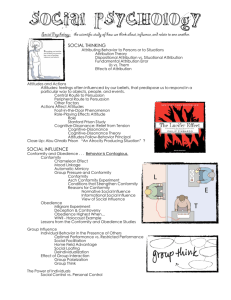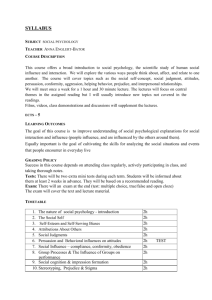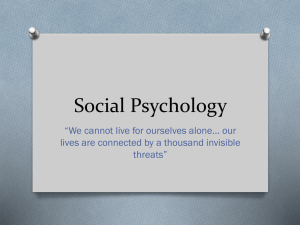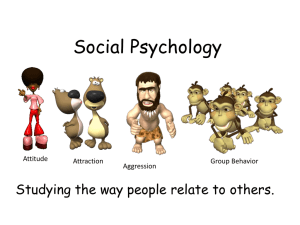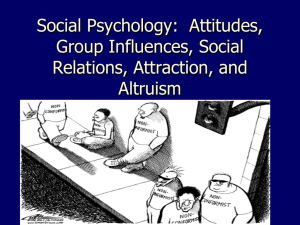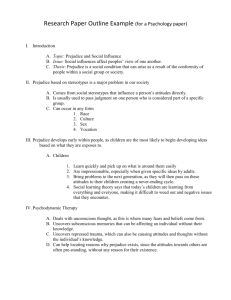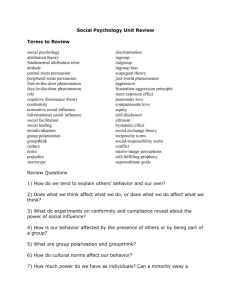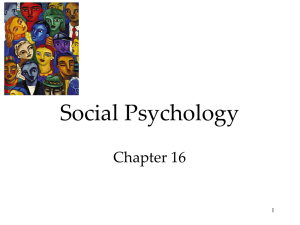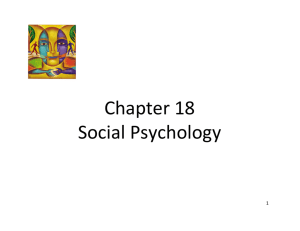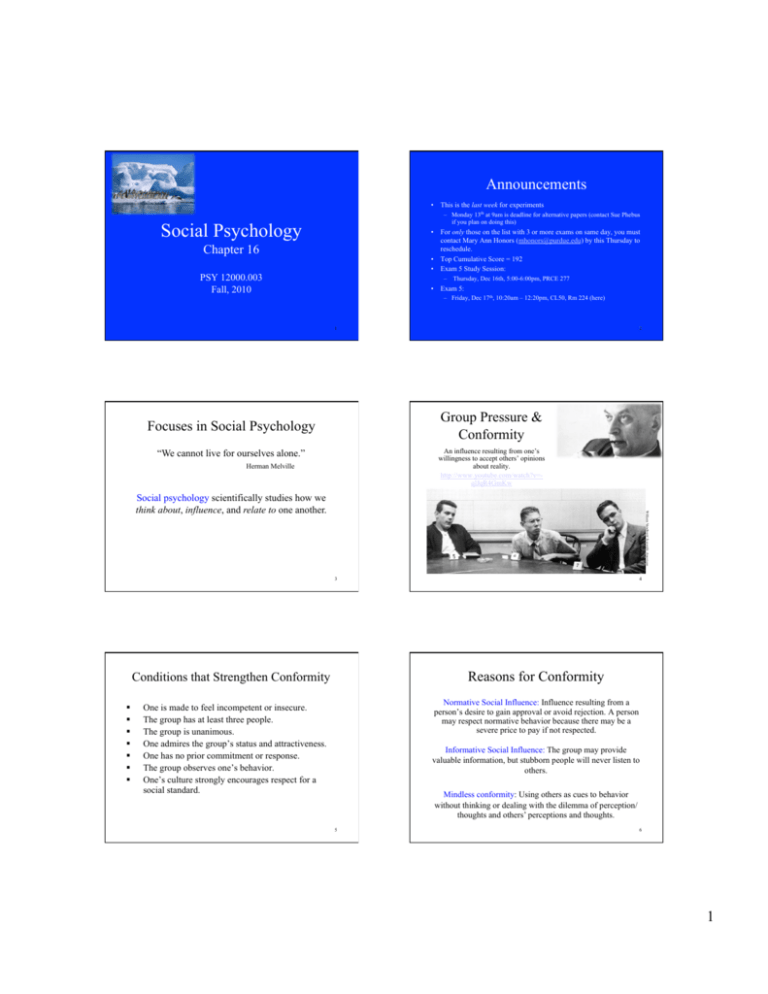
Announcements
• This is the last week for experiments
– Monday 13th at 9am is deadline for alternative papers (contact Sue Phebus
if you plan on doing this)
Social Psychology
• For only those on the list with 3 or more exams on same day, you must
contact Mary Ann Honors (mhonors@purdue.edu) by this Thursday to
reschedule.
• Top Cumulative Score = 192
• Exam 5 Study Session:
Chapter 16
PSY 12000.003
Fall, 2010
– Thursday, Dec 16th, 5:00-6:00pm, PRCE 277
• Exam 5:
– Friday, Dec 17th, 10:20am – 12:20pm, CL50, Rm 224 (here)
1
2
Group Pressure &
Conformity
Focuses in Social Psychology
An influence resulting from one’s
willingness to accept others’ opinions
about reality.
http://www.youtube.com/watch?v=qlJqR4GmKw
“We cannot live for ourselves alone.”
Herman Melville
William Vandivert/ Scientific American
Social psychology scientifically studies how we
think about, influence, and relate to one another.
3
Reasons for Conformity
Conditions that Strengthen Conformity
4
Normative Social Influence: Influence resulting from a
person’s desire to gain approval or avoid rejection. A person
may respect normative behavior because there may be a
severe price to pay if not respected.
One is made to feel incompetent or insecure.
The group has at least three people.
The group is unanimous.
One admires the group’s status and attractiveness.
One has no prior commitment or response.
The group observes one’s behavior.
One’s culture strongly encourages respect for a
social standard.
Informative Social Influence: The group may provide
valuable information, but stubborn people will never listen to
others.
Mindless conformity: Using others as cues to behavior
without thinking or dealing with the dilemma of perception/
thoughts and others’ perceptions and thoughts.
5
6
1
Informative Social Influence
Informative Social Influence
Baron and colleagues (1996) made students do an
eyewitness identification task. If the task was easy
(lineup exposure 5 sec.), conformity was low in
comparison to a difficult (1/2 sec. exposure) task.
7
Baron et al., (1996)
8
Obedience
Obedience to Authority
Stanley Milgram designed a
study that investigates the
effects of authority on
obedience.
Courtesy of CUNY Graduate School and University Center
People comply to social
pressures. How would they
respond to outright
command?
• http://www.youtube.com/watch?v=t2PGnHHnRMk
Stanley Milgram
(1933-1984)
9
Milgram’s Study: Results
Both Photos: © 1965 By Stanley Miligram, from the
film Obedience, dist. by Penn State, Media Sales
Milgram’s Study
10
11
12
2
Lessons from the Conformity and
Obedience Studies
Factors that Increase
Obedience
• Authority is physically closer to participant
• Victim is physically further from participant
• Having Co-Participants who willingly (and
without question) obey.
In both Asch's and Milgram's studies, participants
were pressured against following their standards and
be responsive to others.
In Milgram’s study, participants were torn between
hearing the victims pleas, their own values, and the
experimenter’s orders.
13
Power of the Situation:
Stanford Prison Study
14
Role Playing Affects Attitudes
Zimbardo (1972) assigned the roles of guards and
prisoners to random students and found that guards
and prisoners developed role- appropriate attitudes.
• http://www.prisonexp.org/psychology/2
• http://www.youtube.com/watch?
v=rmwSC5fS40w&feature=related
Originally published in the New Yorker
Phillip G. Zimbardo, Inc.
15
16
The Chameleon Effect or
Conformity & Obedience
Nonconscious Mimicry
Behavior is contagious, modeled by one followed by
another. We follow behavior of others to conform.
Conformity: Adjusting one’s behavior or thinking
to coincide with a group standard (Chartrand &
Bargh, 1999).
Other behaviors may be an expression of compliance
(obedience) toward authority.
Conformity
Obedience
17
18
3
What Happens When We Don’t
Conform?
Reactions to a Deviate
Group Pressure & Conformity
Suggestibility is a subtle type of conformity,
adjusting our behavior or thinking toward some
group standard.
• Groups create
pressures toward
uniformity
– Pressures to
change deviate
– Pressure to
reject/exclude
deviate
19
Bystander Intervention
20
Reasons for Bystander Effect
• http://www.youtube.com/watch?v=dT192AkivC8
• Pluralistic Ignorance
– Others aren’t helping, so help is probably not
needed (similar to conformity)
• Social Inhibition
– Fear of standing out, making a mistake,
overblowing the situation, etc.
• Diffusion of Responsibility
21
22
Just six months ago…
Social Inhibition
•
Social Inhibition (Petty, Williams, Harkins,
& Latané, 1977: “Bystander Response to a
Cheeseburger”
•
How are Conformity and Social Inhibition
Similar?
Free
Cheesebur
ger
23
24
4
Actions Can Affect Attitudes
Cognitive Dissonance
Why do actions affect attitudes? One explanation is
that when our attitudes and actions are opposed, we
experience tension. This is called cognitive
dissonance.
• We don’t like to hold inconsistent thoughts, or
have a thought that is inconsistent with our
behavior.
• When faced with an inconsistency (for something
relatively important), we experience “cognitive
dissonance.”
• We are motivated to reduce this dissonance.
• We change the belief/attitude to come in line with
the behavior.
To relieve ourselves of this tension we bring our
attitudes closer to our actions (Festinger, 1957).
– 1$/$20 Study by Festinger & Carlsmith
– Severity of initiation by Aronson & Mills
25
Attributing Behavior to Persons or to
Situations
http://www.youtube.com/
watch?v=sZBKer6PMtM
Social Thinking
http://www.stedwards.edu
Attribution Theory: Fritz
Heider (1958) suggested
that we have a tendency to
give causal explanations
for someone’s behavior,
often by crediting either
the situation or the
person’s disposition.
26
Fritz Heider
27
1. Does his absenteeism signify
illness, laziness, or a stressful work
atmosphere?
2. Was the horror of 9/11 the work of crazed
evil people or ordinary people corrupted
by life events?
3. Why was Derek Anderson smiling when
his team was losing so badly?
Social thinking involves thinking about others,
especially when they engage in doing things that are
28
unexpected.
Attributing Behavior to Persons or to
Situations
Fundamental Attribution Error
A teacher may wonder whether a child’s hostility
reflects an aggressive personality (dispositional
attribution) or is a reaction to stress or abuse (a
situational attribution).
The tendency to overestimate the impact of personal
disposition and underestimate the impact of the
situations in analyzing the behaviors of others leads
to the fundamental attribution error.
We see Joe as quiet, shy, and introverted most of the
time, but with friends he is very talkative, loud, and
extroverted.
http://www.bootsnall.org
Dispositions are enduring
personality traits. So, if Joe is
a quiet, shy, and introverted
child, he is likely to be like
that in a number of
situations.
29
30
5
Effects of Attribution
Attitude
How we explain someone’s behavior affects how we
react to it.
A belief and feeling that predisposes a person to
respond in a particular way to objects, other people,
and events.
If we believe a person is mean, we may feel dislike
for the person and act in an unfriendly manner.
31
32
Attitudes Can Affect Action
Attitudes Can Affect Action
Our attitudes predict our behaviors imperfectly
because other factors, including the external situation,
also influence behavior.
Not only do people stand for what they believe in
(attitude), they start believing in what they stand for.
33
D. MacDonald/ PhotoEdit
Democratic leaders supported Bush’s attack on Iraq
under public pressure. However, they had their private
reservations.
Cooperative actions can lead to mutual liking (beliefs).
34
Small Request – Large Request
Social Influence
In the Korean War, Chinese communists solicited
cooperation from US army prisoners by asking them
to carry out small errands. By complying to small
errands they were likely to comply to larger ones.
The greatest contribution of social psychology is its
study of attitudes, beliefs, decisions, and actions and
the way they are molded by social influence.
Foot-in-the-Door Phenomenon: The tendency for
people who have first agreed to a small request to
comply later with a larger request.
35
36
6
Individual Behavior in the Presence of
Others
Group Influence
One person affecting another
Families
Teams
Committees
37
Michelle Agnis/ NYT Pictures
Social facilitation: Refers
to improved performance
on tasks in the presence of
others. Triplett (1898)
noticed cyclists’ race times
were faster when they
competed against others
than when they just raced
against the clock.
How do groups affect our behavior? Social
psychologists study various groups:
38
Social Loafing
Deindividuation
The tendency of an individual in a group to exert less
effort toward attaining a common goal than when
tested individually (Latané, Williams, & Harkins,
1981).
The loss of self-awareness and self-restraint in group
situations that foster arousal and anonymity.
39
Effects of Group Interaction
Mob behavior
40
Groupthink
Group Polarization
enhances a group’s
prevailing attitudes
through a discussion. If a
group is like-minded,
discussion strengthens its
prevailing opinions and
attitudes.
A mode of thinking that occurs when the desire for
harmony in a decision-making group overrides the
realistic appraisal of alternatives.
• Attack on Pearl Harbor
• Kennedy and the Cuban Missile Crisis
• Watergate Cover-up
• Chernobyl Reactor Accident
41
42
7
Power of Individuals
Social Relations
Non-violent fasts and
appeals by Gandhi led to
the independence of
India from the British.
Margaret Bourke-White/ Life Magazine. © 1946 Time Warner, Inc.
The power of social
influence is enormous,
but so is the power of the
individual.
Social psychology teaches us how we relate to one
another through prejudice, aggression, and conflict
to attraction, and altruism and peacemaking.
Gandhi
43
44
Prejudice
Reign of Prejudice
Simply called “prejudgment,” a prejudice is an
unjustifiable (usually negative) attitude toward a
group and its members. Prejudice is often directed
towards different cultural, ethnic, or gender groups.
Prejudice works at the conscious and [more at] the
unconscious level. Therefore, prejudice is more like
a knee-jerk response than a conscious decision.
Components of Prejudice
1. Beliefs (stereotypes)
2. Emotions (hostility, envy, fear)
3. Predisposition to act (to discriminate)
45
46
How Prejudiced are People?
Racial & Gender Prejudice
Over the duration of time many prejudices against
interracial marriage, gender, homosexuality, and
minorities have decreased.
Americans today express much less racial and
gender prejudice, but prejudices still exist.
47
48
8
Race
Gender
Nine out of ten white respondents were slow when
responding to words like “peace” or “paradise” when
they saw a black individual’s photo compared to a
white individual’s photo (Hugenberg &
Bodenhausen, 2003).
Most women still live in more poverty than men.
About 100,000,000 women are missing in the world.
There is a preference for male children in China and
India, even with sex-selected abortion outlawed.
49
Gender
50
Social Roots of Prejudice
Although prejudice prevails against women, more
people feel positively toward women than men.
Women rated picture b [feminized] higher (665) for a
matrimonial ad (Perrett, 1998).
Why does prejudice arise?
Professor Dave Perrett, St. Andrews University
Social Inequalities
Social Divisions
Emotional Scapegoating
51
52
Social Inequality
In and Out Groups
Prejudice develops when people have money, power,
and prestige, and others do not. Social inequality
increases prejudice.
Ingroup: People with whom one shares a common
identity. Outgroup: Those perceived as different from
one’s ingroup. Ingroup Bias: The tendency to favor
one’s own group.
Mike Hewitt/ Getty Images
53
Scotland’s famed “Tartan Army” fans.
54
9
Emotional Roots of Prejudice
Cognitive Roots of Prejudice
Prejudice provides an outlet for anger [emotion] by
providing someone to blame. After 9/11 many
people lashed out against innocent ArabAmericans.
One way we simplify our world is to categorize. We
categorize people into groups by stereotyping
them.
Michael S. Yamashita/ Woodfin Camp Associates
55
56
Foreign sunbathers may think Balinese look alike.
Cognitive Roots of Prejudice
Cognitive Roots of Prejudice
In vivid cases such as the 9/11 attacks, terrorists can
feed stereotypes or prejudices (terrorism). Most
terrorists are non-Muslims.
The tendency of people to believe the world is just,
and people get what they deserve and deserve what
they get (the just-world phenomenon).
© The New Yorker Collection, 1981, Robert Mankoff from cartoonbank.com. All Rights Reserved.
57
Hindsight Bias
Aggression
After learning an outcome, the tendency to believe
that we could have predicted it beforehand may
contribute to blaming the victim and forming a
prejudice against them.
Aggression can be any physical or verbal behavior
intended to hurt or destroy.
It may be done reactively out of hostility or
proactively as a calculated means to an end.
58
Research shows that aggressive behavior emerges
from the interaction of biology and experience.
59
60
10
The Biology of Aggression
Influences
Three biological influences on aggressive behavior
are:
Genetic Influences: Animals have been bred for
aggressiveness for sport and at times for research.
Twin studies show aggression may be genetic. In men,
aggression is possibly linked to the Y chromosome.
1. Genetic Influences
2. Neural Influences
3. Biochemical Influences
Neural Influences: Some centers in the brain,
especially the limbic system (amygdala) and the
frontal lobe, are intimately involved with aggression.
61
62
Influences
The Psychology of Aggression
Biochemical Influences: Animals with diminished
amounts of testosterone (castration) become docile, and
if injected with testosterone aggression increases.
Prenatal exposure to testosterone also increases
aggression in female hyenas.
Four psychological factors that influence aggressive
behavior are:
1.
2.
3.
4.
Dealing with aversive events
Learning aggression is rewarding
Observing models of aggression
Acquiring social scripts
63
64
Aversive Events
Environment
Studies in which animals and humans experience
unpleasant events reveal that those made miserable
often make others miserable.
Even environmental temperature can lead to
aggressive acts. Murders and rapes increased with the
temperature in Houston.
Jeff Kowalsky/ EPA/ Landov
Ron Artest (Pacers) attack on Detroit Pistons fans.
65
66
11
Frustration-Aggression Principle
Learning that Aggression is Rewarding
A principle in which frustration (caused by the
blocking of an attempt to achieve a desired goal)
creates anger, which can generate aggression.
When aggression leads to desired outcomes, one learns
to be aggressive. This is shown in both animals and
humans.
Cultures that favor violence breed violence. ScotchIrish settlers in the South had more violent tendencies
than their Quaker Dutch counterparts in the Northeast
of the US.
67
Observing Models of Aggression
68
Acquiring Social Scripts
Sexually coercive men are
promiscuous and hostile in
their relationships with
women. This coerciveness
has increased due to
television viewing of Rand X-rated movies.
The media portrays social scripts and generates mental
tapes in the minds of the viewers. When confronted
with new situations individuals may rely on such social
scripts. If social scripts are violent in nature, people
may act them out.
69
Do Video Games Teach or Release
Violence?
70
Summary
The general consensus on violent video games is
that, to some extent, they breed violence.
Adolescents view the world as hostile when they get
into arguments and receive bad grades after playing
such games.
71
72
12
Conflict
A Game of Social Trap
Conflict is perceived as an incompatibility of actions,
goals, or ideas.
By pursuing our self-interest and not trusting others,
we can end up losers.
A Social Trap is a situation in which the conflicting
parties, by each rationally pursuing their self-interest,
become caught in mutually destructive behavior.
73
74
Enemy Perceptions
Psychology of Attraction
People in conflict form diabolical images of one
another.
1. Proximity: Geographic nearness is a powerful
predictor of friendship. Repeated exposure to novel
stimuli increases their attraction (mere exposure
effect).
75
Rex USA
http://www.aftonbladet.se
http://www.cnn.com
George Bush
“Evil”
Saddam Hussein
“Wicked Pharaoh”
A rare white penguin born in a
zoo was accepted after 3
weeks by other penguins just
due to proximity.
76
Psychology of Attraction
Psychology of Attraction
2. Physical Attractiveness: Once proximity affords
contact, the next most important thing in attraction
is physical appearance.
3. Similarity: Similar views among individuals causes
the bond of attraction to strengthen.
Similarity breeds content!
Brooks Kraft/ Corbis
Brooks Kraft/ Corbis
77
78
13
Romantic Love
Romantic Love
Passionate Love: An aroused state of intense positive
absorption in another, usually present at the beginning
of a love relationship.
Companionate Love: A deep, affectionate attachment
we feel for those with whom our lives are intertwined.
Courtship and Matrimony (from the collection of Werner Nekes)
Two-factor theory of emotion
Physical arousal plus cognitive appraisal
Arousal from any source can enhance one emotion
depending upon what we interpret or label the
arousal
79
80
Altruism
Bystander Effect
Tendency of any given
bystander to be less likely
to give aid if other
bystanders are present.
An unselfish regard for the welfare of others.
Equity: A condition in which people receive
from a relationship in proportion to what they
give.
Self-Disclosure: Revealing intimate aspects
of oneself to others.
81
82
Bystander Intervention
The Norms for Helping
The decision-making process for bystander
intervention.
Social Exchange Theory: Our social behavior is an
exchange process. The aim is to maximize benefits
and minimize costs.
Akos Szilvasi/ Stock, Boston
83
Reciprocity Norm: The expectation that we should
return help and not harm those who have helped us.
Social–Responsibility Norm: Largely learned, it is a
norm that tells us to help others when they need us
even though they may not repay us.
84
14
Peacemaking
Superordinate Goals are shared goals that override
differences among people and require their
cooperation.
Graduated & Reciprocated Initiatives in TensionReduction (GRIT): This is a strategy designed to
decrease international tensions. One side recognizes
mutual interests and initiates a small conciliatory act
that opens the door for reciprocation by the other
party.
Syracuse Newspapers/ The Image Works
Peacemaking
Communication and understanding developed through
talking to one another. Sometimes it is mediated by a
third party.
85
86
15

